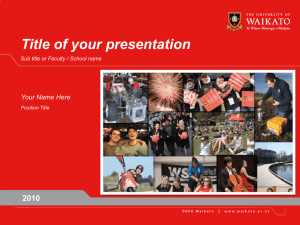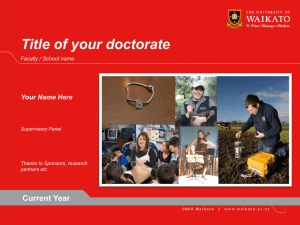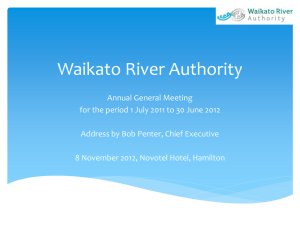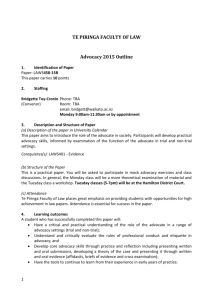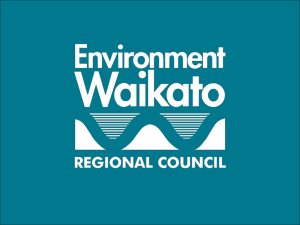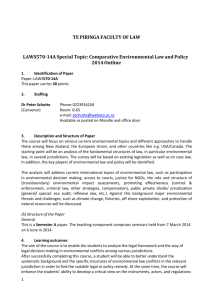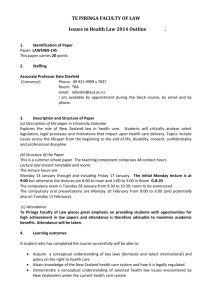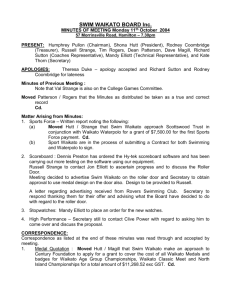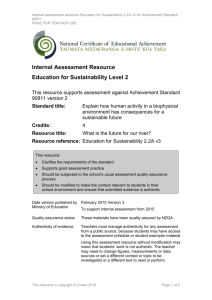Meeting notes
advertisement
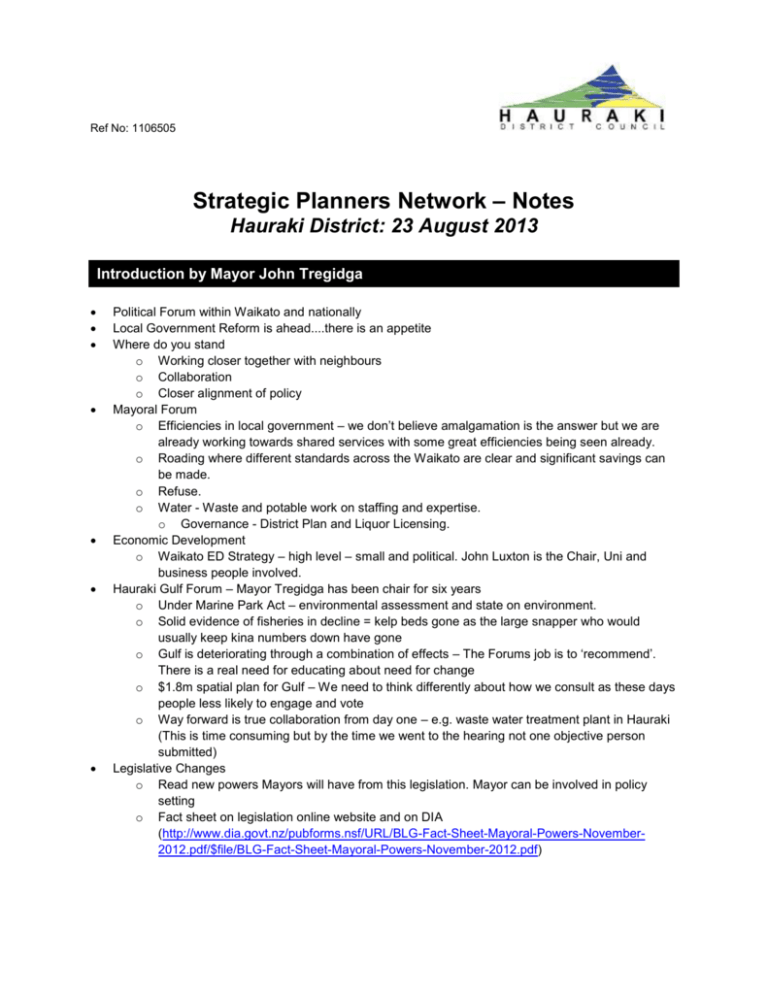
Ref No: 1106505 Strategic Planners Network – Notes Hauraki District: 23 August 2013 Introduction by Mayor John Tregidga Political Forum within Waikato and nationally Local Government Reform is ahead....there is an appetite Where do you stand o Working closer together with neighbours o Collaboration o Closer alignment of policy Mayoral Forum o Efficiencies in local government – we don’t believe amalgamation is the answer but we are already working towards shared services with some great efficiencies being seen already. o Roading where different standards across the Waikato are clear and significant savings can be made. o Refuse. o Water - Waste and potable work on staffing and expertise. o Governance - District Plan and Liquor Licensing. Economic Development o Waikato ED Strategy – high level – small and political. John Luxton is the Chair, Uni and business people involved. Hauraki Gulf Forum – Mayor Tregidga has been chair for six years o Under Marine Park Act – environmental assessment and state on environment. o Solid evidence of fisheries in decline = kelp beds gone as the large snapper who would usually keep kina numbers down have gone o Gulf is deteriorating through a combination of effects – The Forums job is to ‘recommend’. There is a real need for educating about need for change o $1.8m spatial plan for Gulf – We need to think differently about how we consult as these days people less likely to engage and vote o Way forward is true collaboration from day one – e.g. waste water treatment plant in Hauraki (This is time consuming but by the time we went to the hearing not one objective person submitted) Legislative Changes o Read new powers Mayors will have from this legislation. Mayor can be involved in policy setting o Fact sheet on legislation online website and on DIA (http://www.dia.govt.nz/pubforms.nsf/URL/BLG-Fact-Sheet-Mayoral-Powers-November2012.pdf/$file/BLG-Fact-Sheet-Mayoral-Powers-November-2012.pdf) New Local Government Purpose Hauraki District Council (HDC) is attempting to incorporate through decision making processes, procurement policies and general reporting mechanisms. o D-M processes include templates which specifically ask if the project meets the purpose ensuring all staff members have considered it. o Procurement Policy is currently in draft but looking at emphasis on purpose statement and rolling this out to procedures manual. Waikato District Council (WRC) processes weren’t heavily reliant on wellbeing. Issues in discretionary funding area. Trying to get some criteria that would suit the funding. Inconsistency between the consistency. o E.g. fund to pay rugby in another country – but if we don’t do that how do leaders come through. o Different approaches – highlighting that there has to be a local benefit. WRC – identified criteria and assessing their projects against them. A succinct summary of work streams for New Councillors Hamilton City Council (HCC) Improvement programme for Asset Managers – (Aaron happy to share work) o HCC Councillors very engaged in new purpose. Post election will see some major changes. Thames Coromandel District Council (TCDC) complete activity review within 6 months and have reviewed grants policy. Matamata Piako District Council (MPDC) built into Annual Plan process whether the grants do meet new purpose statement. Trying to get MOU set up to agree that they do fall into new purpose. Marginal and high risk challenges. Looking at building D-M. WDC moving from Asset Management Plan to Activity Management Plan. They will forms basis of LTP. Happy that activities align with that. On board with moving from asset to activity plans so no problems. Consultation on Annual Plan (AP) HDC – just starting to plan consultation on LTP. AP low key, summary to key stakeholders, fliers to out of towners, radio. 19 submissions. Treat AP/AR as machinery but LTP has more emphasis. MPDC – low level consultation – some stakeholder meetings farmers/businesses. Did not have appetite. 121 submissions. WDC – run of mill, little change. Heap of consultation with key stakeholders, community meetings. 300 submissions. AR road show. Developing a community engagement strategy. TCDC – historically higher submissions. This AP 150 submissions on other matters and 650 on fluoride. Thinking of going to organised community events. Pre-consultation with board planning. Comm’s team use different social media – Facebook/twitter/website. 400 responses to LAP survey – a lot done on line. HCC – minimal AP consultation. 1600 submissions on fluoride! Population Health – health promoters – made point that people who want to engage don’t want to fill in forms. WDC – how do we capture verbal conversations? Would like to know an answer. Community workshops really help. HCC happy to talk about fluoride tribunal if anyone interested. Waipa – No big issues but still want to 8-10 organisations/meetings. Went to Kite day and did an activity. Used online rates calculate to show people. Attended market days. Online submissions – 74% f them were online. TCDC – Need to spread the work within your own networks. SWDC – Used survey monkey. $300 for a year’s registration. Dr Bill Cochrane – Waikato University – (presentation attached) If you don’t have evenly sized cohorts then it makes it hard to plan infrastructure. Waikato has a hollowing out of age structure in prime age groups. Waikato – middle NZ. Interesting as its sort of the middle of any change Within Waikato there are considerable changes in age structure between TAs – Heterogeneity (non uniform). In migration to the area - TCDC – typical of sunshine areas. Older populations. Population growth followed by sudden drop. Demographic structure changing on farms. Classic family of 2.3 has been replaced by two farm workers. This has impacted on rural schools. Now community ceases to exist as schools gone which sued to encourage friendships. Populating aging is not just a local issue - By 2050 baby boom will have worked its way through. Infinitely ageing population will not happen as they simply pass away so Council need to think about infrastructure use once older population vanishes – what do we do with it? Think long term – future proofing. National government is ignoring the issue of Councils bearing the costs of lower populations. National population and spatial planning required. Vast levels of heterogeneity will be experienced. European approach is to plan and resource for regions to experience decline and not abandon peripheral pop islands. Peripheral labour markets – subsidies local employment by local governments. Will the new National policy on mortgages effect population or internal migration? Proposals in past and future have not changed population. Not likely to affect in future. May have a small impact but over 50 years it would not show. May mean decline in ownership, not necessarily population. Property developers are only ones who will be able to purchase. We are seeing both now and into the future; that people will not or do not want to locate somewhere if places don’t offer services to high speed internet have close access to airports / contain decent restaurants/coffee etc Exclude from meaningful employment, own a home, employment goes, transaction costs for greater than any benefit. Moving elsewhere it pointless. How is migration captured around the worls? Philipino labour - visas usually track that. RES scheme also tracks - International migration is not captured. Does not capture labour migrants. Contemporaneous migration. Population registration. Greg Morton – Waikato Regional Council Transport Planning o Strategic Planning o Re. LT Plan o Public Transport Plan Changes to Act have streamlined planning. 30 years.....now ten years Requirements to look social have been stripped. RLTP policy section up front – programme or inventory of activities at the back. RT Committee has Mayors on board, making decisions and adopting plan on behalf of the region. Public transport - Increasing push to see things at a larger scale - Upper North Island Strategic alliance looking at freight and transport and economic development. Link with spatial plan. Will be considering spatial plan, demographics and others. Travel demand management – road safety – investment in roading key drivers. Happy to update through SPN. Request for planners – please contact Greg to sit on working party Greg.Morton@waikatoregion.govt.nz Peter Thom – Local Alcohol Policy LAP – presented a PowerPoint – presentation attached Psychoactive substances - Locally Approved Product Policy – HCC are looking to develop something urgently but probably post election. DLC anyone advertising? Only HDC Katina Conomos – Thames Coromandel District Council Presentation made on the progress and changes in Wellington, affecting local government – presentation attached. Adrian De Laborde – Hauraki Rail Trail (HRT) HRT – partnership approach, key learnings Consultation is key – “you haven’t consulted with me unless you’ve agreed with me” Beat Huser – MARCO update Here some progress notes on the MARCO work: 1. Waikato Regional MARCO Indicators - Annual data collation and analysis of the 75 MARCO indicators Of the total 75 indicators 25 have been updated The searchable spreadsheet with all data, graphs, references and other metadata is available from http://www.choosingfutures.co.nz/Publications/ The website has been updated, including Report Cards (regional level only) http://www.choosingfutures.co.nz/ The comprehensive report is currently in the WRC peer review process and will be published on MARCO website end August 2013 Next update planned for early/mid 2014, will be comprehensive as it includes all the new census data and updates of the 20 perception indicators (see below) 2. Collaborative MARCO Regional Perception Survey Survey and data analysis completed Results currently being reviewed by participating councils (WRC, TCDC, MPDC, Waipa, South Waikato, Waikato, Hamilton) Reports (regional overview and separate reports for each participating TA) will be published by 15 Sept 2013 on MARCO website, http://www.choosingfutures.co.nz/Publications/. 3. Genuine Progress Index (GPI) Building on the MARCO indicators, WRC has started work to develop a set of key measures on economic, environmental and social/cultural aspects to monitor, assess and regularly report on progress and wellbeing of the Waikato region. Feel free to contact me if you have any questions or comments. Hope you have an enjoyable and productive SPN meeting. Regards Beat Huser
